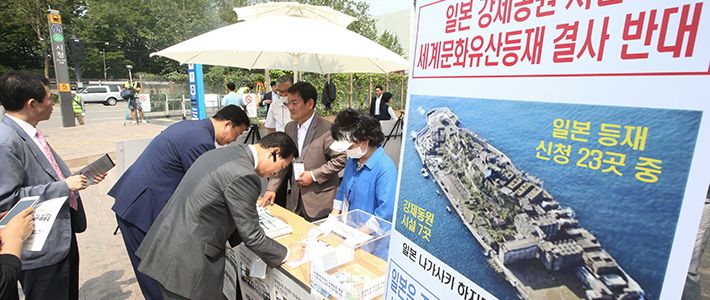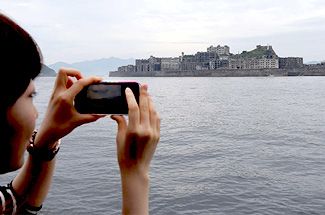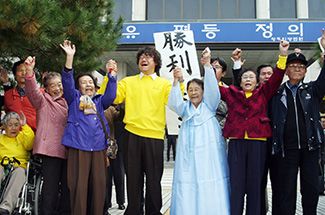
Seoul’s Last-Minute Campaign to Derail Japan’s World Heritage Bid
Politics- English
- 日本語
- 简体字
- 繁體字
- Français
- Español
- العربية
- Русский
The July 2015 meeting of the United Nations Educational, Scientific, and Cultural Organization’s World Heritage Committee did not go as usual. The session brought a sharp confrontation between Japan and South Korea over the proposal to inscribe the “Sites of Japan’s Meiji Industrial Revolution” on the UNESCO World Heritage List, as had been endorsed by the International Council on Monuments and Sites (ICOMOS) in May. The lively lobbying by Japan and South Korea, both internationally influential countries, caused considerable perplexity among the other countries involved. For example, a Serbian delegate was reported to have complained that dealing with the South Koreans over the Japanese bid was taking more time than handling Serbia’s own bid; the delegate wished the two countries would find a middle ground and compromise.
Why did this matter develop into such a major issue? In this article I will consider this question, focusing on the position of the South Korean government.
Seoul’s Sudden Change of Heart
Let us turn the clock back and look at the starting point for this issue. The initial impetus came from local governments in Kyūshū, the location of many of the historic sites relating to Japan’s industrialization and modernization. About a decade ago local authorities launched a joint drive to promote recognition of these sites, and in 2006 they submitted their candidates for inscription on UNESCO’s tentative list of World Heritage sites to Japan’s Agency for Cultural Affairs. In 2008 the agency decided to apply for inscription of these sites, and the following year they were added to the tentative list as “The Modern Industrial Heritage Sites in Kyūshū and Yamaguchi.”
▼Further reading
|
In 2013 the Japanese government decided to single out these sites from the tentative list and seek their inscription on the World Heritage List. In the following year it submitted its official nomination to UNESCO, titling it “Sites of Japan’s Meiji Industrial Revolution: Kyūshū-Yamaguchi and Related Areas” (here “Meiji” refers to the Meiji era, 1868–1912). This nomination was the basis for the aforesaid decision by ICOMOS to endorse the inclusion of these sites.
The key point to note here is that the World Heritage listing came more than 10 years after the initial moves by local authorities in Kyūshū and 6 years after the sites were included in the tentative list. But it was only after the ICOMOS endorsement of Japan’s bid in May this year that the matter suddenly emerged as a bilateral issue between Tokyo and Seoul. Until then, the South Korean government had not conducted any vigorous activities in protest against the proposed listing.
What caused Seoul to shift its stance? It was certainly not because the contents of the Japanese proposal had changed over the previous 10 years or 6 years. For example, the island of Hashima (commonly called Gunkanjima, or Battleship Island), which became the focus of attention when the South Koreans started objecting to the proposed listing, was among the candidate sites from the time of the initial moves by local governments in Kyūshū. And the authorities in Seoul cannot have been unaware of the fact that Hashima (formerly the site of a major coal mining facility) was a place where mobilized Koreans had been put to work during World War II, since this had been reported in the South Korean media in 2008. The absence of objections from Seoul prior to this May indicates that until then the South Korean government did not consider this matter to be particularly important.
Korean Alarm at Abe’s Diplomatic Successes
So why did Seoul suddenly start stressing this matter after ICOMOS endorsed Tokyo’s bid? To answer this question, we must naturally consider the situation in which the South Korean government found itself at that stage.
As of this May, the administration of President Park Geun-hye was under a barrage of domestic criticism relating to the differences between Japan and South Korea over historical perceptions. This criticism was fueled by the successes achieved by Japan’s Prime Minister Abe Shinzō in his summitry during April. Abe delivered a well-received address at the Asian-African Summit on April 22, using the occasion to set forth his own views about history. And while in Jakarta for this conference, he was able to meet with China’s President Xi Jinping in the second Japan-China summit meeting since he became prime minister in December 2012. Abe then visited the United States, where he addressed a joint meeting of the US Congress on April 30; this speech was also welcomed for the most part by the American public.
For the Park administration in Korea, which has been vying with Japan over historical perceptions in the court of international public opinion and which has declined to hold a bilateral summit between Park and Abe, mainly because of the two countries’ differences over the comfort-women issue, Abe’s successful performances in Jakarta and Washington were a source of considerable alarm. The South Korean public was also irritated by this course of developments. The South Koreans thought they had the upper hand over Japan in the competition for international support with respect to views of history, and so Abe’s successes came as a shock to them, making them critical of their own government for its inability to prevent this outcome.
The UNESCO Endorsement as Seen from South Korea
On top of that, around the time when Abe was in Jakarta for the Asian-African Summit, meeting with President Xi and putting on a show of improvement in Japan-China relations, South Korea was marking the first anniversary of the Sewol ferry sinking tragedy of April 16, 2014. But on that day President Park departed on a tour of Latin America. People in South Korea felt that she was turning her back on domestic affairs and that she was also bungling on the diplomatic front with her absence from Jakarta. This assessment made them even more critical of their government.
In this context, the endorsement of Japan’s bid by ICOMOS—a move that seemed abrupt to the South Koreans, who had not been focusing on this issue up to then—came to have a special significance to them. As they saw it, UNESCO, the organ responsible for matters relating to historical perceptions within the United Nations, the world’s most important international institution, had given its backing to the historical views of Japan—that is to say, the views of the Abe administration. In other words, they saw the decision by ICOMOS as symbolizing their loss of the upper hand in the competition with Japan over historical perceptions.
This is why the South Korean government proceeded to undertake an intensive campaign to block final approval of the listing. As seen from Seoul, the meeting of the UNESCO World Heritage Committee was a crucial battlefield in the fight between Japan and South Korea for support from the international community for their respective views of history.
Compensation for Wartime Conscription: Seoul’s Dilemma
There is one more factor behind Seoul’s focus on this matter: Within South Korea, the idea of World Heritage listing for Japan’s industrialization sites is positioned as relating to the issue of Japan’s mobilization of Koreans as laborers during the height of World War II.
In May 2012 South Korea’s Supreme Court ruled that people drafted to work at the former Nippon Steel (now Nippon Steel & Sumitomo Metal) and Mitsubishi Heavy Industries during World War II and their surviving family members had the right to claim compensation. Since then, the issue of compensation for those who were mobilized in Korea as laborers during the war has emerged as a major new issue relating to the differing historical perceptions of Japan and South Korea. At the same time, it has created a serious dilemma for the South Korean government.
Though the South Korean judiciary has come out in favor of the right to claim compensation for wartime conscripted laborers, it is clear that the South Korean and Japanese governments addressed this issue squarely in the negotiations that led to the conclusion of the 1965 Treaty on Basic Relations Between Japan and the Republic of Korea and that compensation for such laborers was one of the bases for calculation of the “economic cooperation” funds that Japan agreed to pay South Korea under this treaty. For this reason, Seoul has not been able to adopt a clear-cut position on this issue, unlike the issue of the comfort women, and the South Korean authorities are not confident that they can negotiate successfully with Japan on this matter. People close to the South Korean government have been heard to say that South Korea would have little chance of winning a favorable judgment if the issue of conscripted laborers were to be brought before an arbitration panel under the provisions of the relevant annex to the 1965 treaty.
Focusing on the Forced Nature of the Work
In this context, Seoul must have seen the sudden emergence of the World Heritage sites issue as a great opportunity to push back against Tokyo in the debate over wartime mobilization of workers, which is a matter on which the South Koreans are at a disadvantage in terms of international law. The course the South Korean government chose was to focus the attention of the international community on the “forced” nature of the working environment for the mobilized Koreans, so as to create the impression that the actions of the wartime Japanese government were beyond the pale under international law. And this choice was probably informed by its experience in the debate over the comfort women.
The position of the South Korean government and activist groups regarding the issue of the comfort women, which initially focused on the forced nature of their recruitment, has since shifted to a focus on the forced nature of their work. In other words, the debate has shifted to their status in terms of human rights. And Seoul has now started applying the same logic with regard to the conscripted workers. Though the conscription clearly became mandatory under law only toward the end of the war, prior to that the recruitment of laborers from Korea for work in Japan was conducted by companies, sometimes with assistance from the government, and so the extent to which it was “forced” is unclear. This makes it difficult for the South Koreans to pin blame on Japan for forced recruitment based on the outright use of government authority. But as they see it, the prospects for claiming compensation may be better if they can establish that the recruited laborers ended up working under forced conditions and can link the claims to the illegality of this compulsion.
The South Korean authorities’ position was clearly visible in the demand they pressed on Japan at the bilateral foreign ministers’ meeting just before the UNESCO committee session and during the subsequent negotiations between the two countries—namely, that Japan agree to include the term “forced labor” in an official statement regarding the World Heritage listing. This term is internationally recognized as referring to actions prohibited under the 1930 Forced Labor Convention of the International Labor Organization. In the end the two countries agreed on an ambivalent formulation, with Japan issuing a statement that avoided the term “forced labor” but included the phrase “forced to work” in a reference to the conscripted Koreans.
A Double Win for Seoul
Even the inclusion of this phrase represented a major success for Seoul, inasmuch as it highlighted the “forced” nature of Japan’s wartime mobilization of laborers in the debate conducted in view of the international community. This is a matter that has repeatedly come up for discussion in the ILO and other international forums, where it has resulted in considerable criticism of Japan.
▼Further reading
|
Particularly significant was the report issued in 1999 by the ILO’s Committee of Experts on the Application of Conventions and Recommendations, which identified Japan’s wartime mobilization of non-Japanese laborers as a clear violation of the convention. In the light of such factors as the extremely high level of mortality among these laborers, the ILO committee judged that Japan’s actions fell outside the scope of ordinary wartime mobilization, which is exempt from the provisions of the convention. It is highly likely that the South Korean authorities were conscious of the existence of this report while they were negotiating with Japan over the bid for World Heritage listing.
What bears noting is that for the South Korean government the issue of World Heritage listing for Japan’s Meiji-era sites was not so much an important issue in its own right as an occasion for the government to show its domestic public that it was putting up a more than even fight against Japan in the arena of international opinion regarding historical perceptions—and also a chance for South Korea to find an advantageous way of handling the knotty issue of compensation for wartime laborers. In this sense it was a double win for Seoul. And it was in fact a major accomplishment for the South Koreans. They are likely to press further on the forced nature of the wartime working conditions for Korean laborers, and we must now see how Tokyo will respond.
(Originally written in Japanese on August 10, 2015. Banner photo: South Koreans sign a petition in Seoul Plaza on June 17, 2015, opposing World Heritage listing for Japan’s “Sites of the Meiji Industrial Revolution.” © Yonhap/Aflo.)China Abe Shinzō South Korea Xi Jinping comfort women Park Geun-hye
 Takeaways from the World Heritage Listing for Sites of Japan’s Meiji Industrial Revolution
Takeaways from the World Heritage Listing for Sites of Japan’s Meiji Industrial Revolution Korean Courts Order Japanese Firms to Compensate Wartime Laborers: Background to the Rulings
Korean Courts Order Japanese Firms to Compensate Wartime Laborers: Background to the Rulings